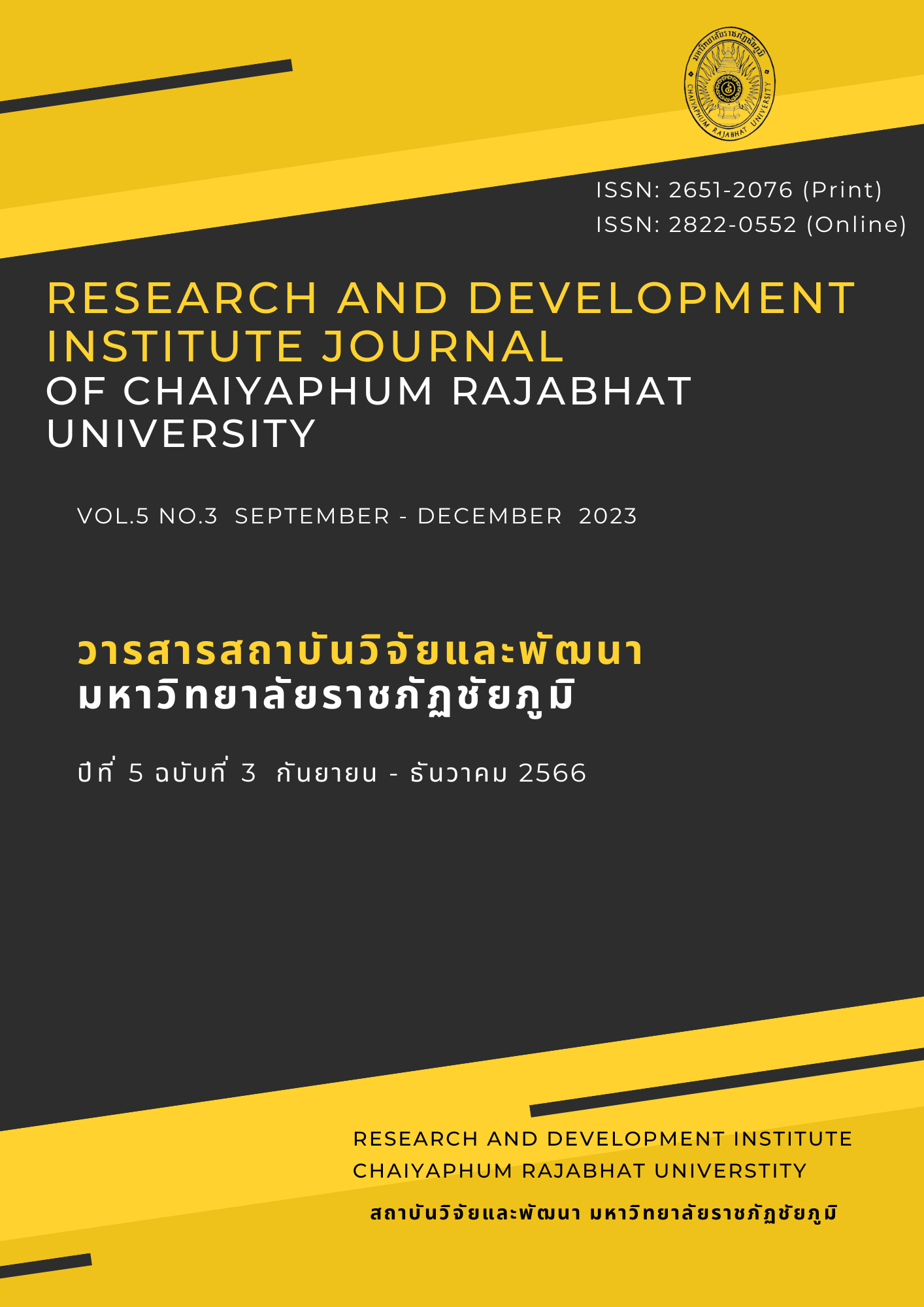การใช้เกมแบบผสมผสานในการส่งเสริมการมีส่วนร่วมในการเรียนรู้ภาษาอังกฤษของนักเรียนระดับประถมศึกษา
Main Article Content
บทคัดย่อ
การมีส่วนร่วมในการเรียนรู้ (learning engagement) เพื่อส่งเสริมการรับรู้เชิงบวกตั้งแต่อายุยังน้อยเป็นประโยชน์ต่อการเรียนภาษาอังกฤษอย่างยิ่ง การศึกษานี้มีวัตถุประสงค์เพื่อ 1) พัฒนาการนวัตกรรมกิจกรรมการใช้เกมแบบผสมผสานสำหรับนักเรียนในระดับประถมศึกษา 2) ศึกษาการมีส่วนร่วมการเรียนรู้ในระหว่างกิจกรรมการใช้เกมแบบผสมผสาน และ 3) ศึกษาความพึงพอใจหลังกิจกรรมการใช้เกมแบบผสมผสาน ผู้เข้าร่วมการวิจัยได้แก่นักเรียนชั้นประถมศึกษาปีที่ 2-5 จำนวน 12 คน ซึ่งเก็บรวบรวมข้อมูลแบบทั้งชั้นเรียนตามสภาพจริง (intact classes) เครื่องมือที่ใช้ในการวิจัยมีสองประเภท ได้แก่ 1) แบบตรวจสอบรายการการมีส่วนร่วมของนักเรียน และ 2) แบบสำรวจความพึงพอใจ ผลการวิจัยพบว่าการพัฒนานวัตกรรมกิจกรรมการใช้เกมแบบผสมผสานนั้นมีองค์ประกอบ 3 ส่วน ได้แก่ สื่อหรือแพลตฟอร์มออนไลน์ สื่อในชั้นเรียนจริง และขั้นตอนของกิจกรรมนั้น และยังพบอีกว่าด้านความคิดริเริ่มและความพยายามของนักเรียนมีสูงมากในระหว่างการทำกิจกรรมการใช้เกมแบบผสมผสาน โดยเฉพาะอย่างยิ่งในระดับชั้นประถมศึกษาปีที่ 5 และ 3 ตามลำดับ ในขณะที่พฤติกรรมก่อกวนและไม่ตั้งใจนั้นค่อนข้างต่ำ อาจเป็นเพราะความเพลิดเพลิน ความตื่นเต้น และการมีส่วนร่วมที่เพิ่มขึ้น ซึ่งทำให้นักเรียนมีความต้องการชนะ ต้องการเรียนรู้ มีความพึงพอใจ และมีการใช้ความคิดในขณะทำกิจกรรม การวิจัยในอนาคตควรมุ่งเน้นไปที่การพัฒนากิจกรรมการใช้เกมแบบผสมผสาน ให้มีความหลากหลายมากกว่าเพียงแพลตฟอร์มออนไลน์ประเภท Kahoot, Quizizz หรือ Padlet และในอนาคตครูผู้สอนควรตระหนักถึงการปรับเปลี่ยนบทเรียนหรือการปรับตัวเมื่อออกแบบกิจกรรมการใช้เกมแบบผสมผสานในชั้นเรียนจริง เพื่อให้เหมาะสมกับระดับภาษาอังกฤษของนักเรียนและทักษะการใช้เทคโนโลยีมากที่สุด
Article Details

อนุญาตภายใต้เงื่อนไข Creative Commons Attribution-NonCommercial-NoDerivatives 4.0 International License.
การอนุญาตให้ใช้ข้อความ เนื้อหา รูปภาพ ฯลฯ ของสิ่งพิมพ์ ผู้ใช้รายใดก็ตามที่จะอ่าน ดาวน์โหลด คัดลอก แจกจ่าย พิมพ์ ค้นหา หรือเชื่อมโยงไปยังข้อความทั้งหมดของบทความ รวบรวมข้อมูลสำหรับการจัดทำดัชนี ส่งต่อเป็นข้อมูลไปยังซอฟต์แวร์ หรือใช้เพื่อวัตถุประสงค์ทางกฎหมายอื่นใด แต่ห้ามนำไปใช้ในเชิงพาณิชย์หรือมีเจตนาเอื้อประโยชน์ทางธุรกิจใดๆ เผยแพร่ภายใต้สัญญาอนุญาตครีเอทีฟคอมมอนส์แบบแสดงที่มา-ไม่ใช้เพื่อการค้า (Creative Commons Attribution-NonCommercial-NoDerivatives 4.0 International License)

This work is licensed under a Creative Commons Attribution-NonCommercial-NoDerivatives 4.0 International License
เอกสารอ้างอิง
Adair, J. G. (1984). The Hawthorne effect: A reconsideration of the methodological artifact. Journal of Applied Psychology, 69(2), 334–345.
Alam, M. J., Islam, S. R. B., & Ogawa, K. (2022). Discrete primary education curriculum in Bangladesh: Implications of gamification for quality education. In Handbook of Research on Acquiring 21st Century Literacy Skills Through Game-Based Learning (pp. 716-730). IGI Global.
Alyousif, R., & Alsuhaibani, Z. (2021). English Language Learning Demotivating Factors for Saudi High School EFL Students. English Language Teaching, 14(8), 29-39.
Arnold, B. J. (2014). Gamification in education. Proceedings of the American Society of Business and Behavioral Sciences, 21(1), 32-39.
Azhar, S. A. F. J., & Ab Jalil, H. (2022). Comparison of Individual and Collaborative Game-Based Learning Using Tablet In Improving Students’ Knowledge In Primary Classroom Environment. Asian Journal of University Education, 18(1), 205-216.
Cadet, M. J. (2023). Application of game-based online learning platform: Kahoot a formative evaluation tool to assess learning. Teaching and Learning in Nursing, 18(3), 419-422.
Common Sense Education. (2022, March). Quizizz: Quiz tool has evolved to become interactive lesson platform. https://www.commonsense.org/education/reviews/quizizz
Coveney, K., Somanadhan, S., Nicholson, E., Piga, S., Pizziconi, V., D'Elpidio, G., & Gazzelloni, A. (2022). First year nursing students’ evaluation of Kahoot! to facilitate learning and testing knowledge. A pilot study in Ireland and Italy. Teaching and Learning in Nursing, 17(2), 163-168.
DeWitt, D., Alias, N., Ibrahim, Z., Shing, N. K., & Rashid, S. M. M. (2015). Design of a learning module for the deaf in a higher education institution using padlet. Procedia-Social and Behavioral Sciences, 176, 220-226.
Diehr, B., & Frisch, S. (2008). Goodbye Hungry Caterpillar. Ein forschungsgestütztes Plädoyer für produktiven Sprachgebrauch im Englischunterricht der Grundschule. Fremdsprachen in der Grundschule. Auf dem Weg zu einer neuen Lern-und Leistungskultur. Frankfurt: Grundschulverband, 142-167.
Fadhli, M., Brick, B., Setyosari, P., Ulfa, S., & Kuswandi, D. (2020). A meta-analysis of selected studies on the effectiveness of gamification method for children. International Journal of Instruction, 13(1). 845-854.
Gaming Respawn. (2023. March 13). Educational Benefits of Online Games for Children and Adults. https://gamingrespawn.com/features/58345/educational-benefits-of-online-games-for-children-and-adults/
Gelisli, Y., & Yazici, E. (2015). A study into traditional child games played in Konya region in terms of development fields of children. Procedia-Social and Behavioral Sciences, 197, 1859-1865.
Grabner-Hagen, M. M., & Kingsley, T. (2023). From badges to boss challenges: Gamification through need-supporting scaffolded design to instruct and motivate elementary learners. Computers and Education Open, 4. doi.org/10.1016/j.caeo.2023.100131
Hafeez, M. (2021). Effects of Game Based Learning in Comparison of Traditional Learning to Provide Effective Learning Environment-A Comparative Review. International Journal of Social Sciences & Educational Studies, 8(4), 100-115.
Ingham, A. G., Levinger, G., Graves, J., & Peckham, V. (1974). The Ringelmann effect: Studies of group size and group performance. Journal of experimental social psychology, 10(4), 371-384.
Kiryakova, G., Angelova, N., & Yordanova, L. (2014, October). Gamification in education. In Proceedings of 9th international Balkan education and science conference (Vol. 1, pp. 679-684).
Li, W., Huang, J. Y., Liu, C. Y., Tseng, J. C., & Wang, S. P. (2023). A Study on the Relationship between Student's Learning Engagements and Higher-order Thinking Skills in Programming Learning. Thinking Skills and Creativity, 49. doi.org/10.1016/j.tsc.2023.101369.
McCallum, S., & Milner, M. M. (2021). The effectiveness of formative assessment: student views and staff reflections. Assessment & Evaluation in Higher Education, 46(1), 1-16.
Mercer, S. (2019). Language learner engagement: Setting the scene. Second handbook of English language teaching, 643-660.
Nemerow, L. G. (1996). Do Classroom Games Improve Motivation and Learning?. Teaching and Change, 3(4).
Polrak, M. (2019). Factors causing demotivation in English learning among Thai students in the Faculty of Agricultural Technology, Kmitl. In The 10th Hatyai National and International Conference (pp. 1807-1819).
Quibrantar, S. M., & Ezezika, O. (2023). Evaluating student engagement and experiential learning in global classrooms: A qualitative case study. Studies in Educational Evaluation, 78. doi.org/10.1016/j.stueduc.2023.101290.
Ricciardi, F., Zardini, A., Czakon, W., Rossignoli, C., & Kraus, S. (2022). Revisiting the cooperation–competition paradox: A configurational approach to short-and long-term coopetition performance in business networks. European Management Journal, 40(3), 320-331.
Software Advice, (2023). Quizizz for Schools Reviews. https://www.softwareadvice.com/k-12/quizizz-profile/reviews/
University of Exeter. (2017, February 3). Emoticons help gauge school happiness level in young children. Phys.org. https://phys.org/news/2017-02-emoticons-gauge-school-happiness-young.html
Wang, M. T., & Holcombe, R. (2010). Adolescents’ perceptions of school environment, engagement, and academic achievement in middle school. American educational research journal, 47(3), 633-662.
Wirani, Y., Nabarian, T., & Romadhon, M. S. (2022). Evaluation of continued use on Kahoot! as a gamification-based learning platform from the perspective of Indonesia students. Procedia Computer Science, 197, 545-556.


